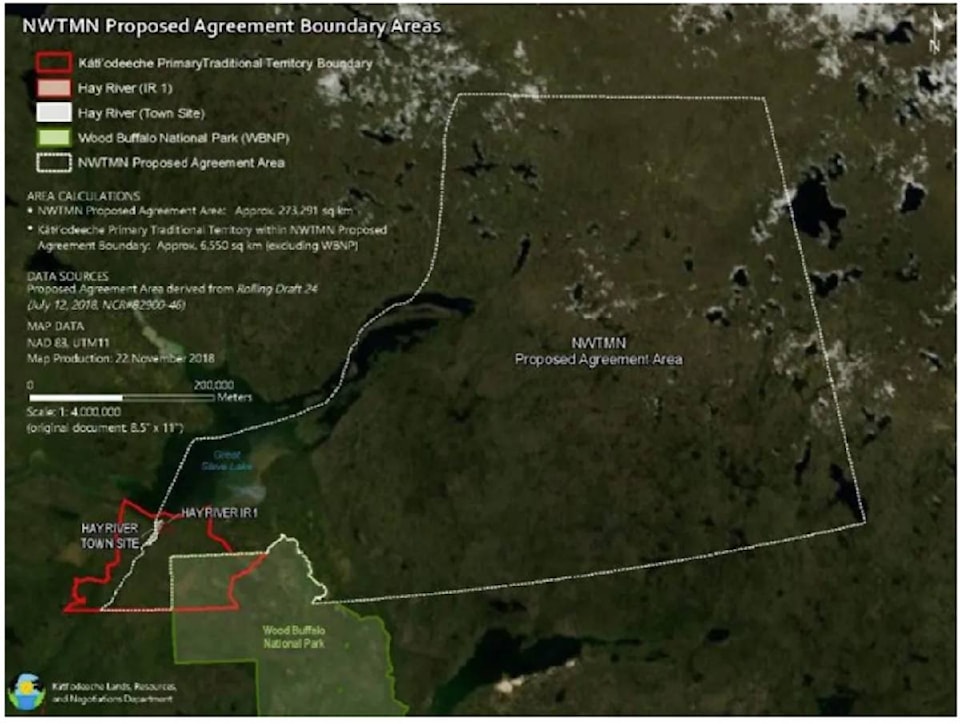A new agreement risks sparking an old dispute between the NWT Metis Nation (NWTMN) and the K’atl’odeeche First Nation (KFN).
The disagreement is related to the Metis Nation’s recent self-government framework agreement signed with the federal and NWT governments on May 19. The deal provides a framework to guide negotiations towards self-government for the NWTMN, part of larger talks on land claims the organization has been holding with the federal government since 1996.
RELATED REPORTING: NWT Metis Nation inks framework deal on self-government
KFN has taken issue with the deal, telling First Nation members in a May 20 notice that a self-government agreement that includes KFN traditional territory would infringe on its Aboriginal and treaty rights.
RELATED REPORTING: KFN registers objections with Metis framework agreement
The notice was also posted on Facebook.
READ HERE: Notice to members
But in an interview with NNSL Media on June 2, NWTMN President Garry Bailey said he rejects the notion that there’s a conflict with the KFN.
“We have a history. We have rights as well in these areas we’re in. They want to spend their money challenging us rather than working together? It’s crazy,” he said. “I’m not going to be picking fights with KFN. My fight is with Canada. I don’t have to prove my rights to other Aboriginal people.”
The KFN’s notice to members added that to avoid an infringement on its rights and titles on traditional land, the NWTMN agreement area boundary should be moved east of KFN territory.
Bailey said he has no direct comment on that idea, but explained in general that the NWTMN doesn’t occupy KFN reserve land and the First Nation’s traditional territory isn’t theirs exclusively.
“It’s a shared traditional territory among all Indigenous peoples in the NWT,” he said.
Any discussions on potential overlap of territories would be dealt with at the appropriate time, Bailey said. For now, the NWTMN is focusing on moving ahead with its new framework agreement.
Recurring issue over land claims
KFN’s dispute with the framework deal is at least the third time in almost three years that the South Slave First Nation has voiced opposition to the Metis Nation’s claims.
Almost one year ago, KFN filed a lawsuit in the Supreme Court of the NWT over what it said was the construction of unauthorized cabins on its territory. The suit was filed against the GNWT, NWTMN and the Hay River Metis Government Council (HRMGC).
RELATED REPORTING: KFN launches legal action over building of ‘unauthorized’ cabins
“They claim to have ‘recognized (section) 35 rights’ to build cabins in our territory,” KFN Chief April Martel said in a news release in July 2020, referring to the Canadian Constitution. “In fact, the NWTMN, HRMGC and its members only started to assert rights within the KFN territory after they began moving to the Town of Hay River.”
The chief said those asserted rights have not been recognized or established by any government or in any court, and not by KFN.
In November 2018, after the NWTMN erected a sign on a highway junction welcoming travellers to its “traditional territory,” members of the KFN council expressed frustration.
RELATED REPORTING: KFN follows the way of the ancestors
The First Nation said at the time that none of its traditional territory should be included in the Metis Nation claim and that its boundary should be moved to the east of KFN territory, which is in the area of the junction of Highway 5 and Highway 6. towards Fort Resolution.
An image from a KFN map of the two land claim areas shows the NWTMN’s proposed agreement areas overlapping most of the KFN’s primary traditional territory boundary, according to a CBC North report from 2018.
RELATED REPORTING: ‘This is our land’: K’atl’odeeche First Nation continues opposition to claims on traditional land
Martel did not respond to repeated requests for comment by press deadline.
The NWTMN’s framework agreement outlines the process for self-government negotiations, including governance of the NWTMN entities, legal status and capacity of Metis governments, administration of lands, Metis government finances, law-making authority, implementation plans and elections for Metis government.
